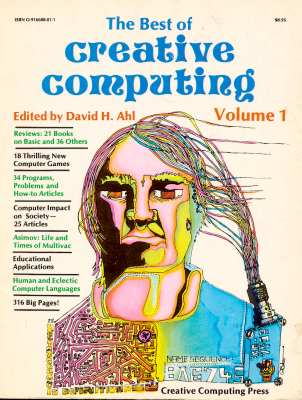
One of the first magazines I can remember subscribing to (apart from Cricket and Ranger Rick) was Creative Computing. I started getting this magazine about 1980, after I fell in love with the neighbor’s TRS-80. It astounded me that he could have a computer sitting right there, on his desk, completely self-contained and no bigger than one of the TTY machines that we used at the University to talk to the mysteriously distant mainframe. (Even though I wasn’t yet a teenager I still had occasional access to the mainframe, thanks to the fact that my dad and my neighbor’s dad were both university professors.) I knew the TRS-80 was a real computer because, like the mainframe, it let me play Wumpus. It also had an early version of Sargon Chess, which even at that primitive level of AI development could still kick my ass. I am not a good chess player.
I immediately latched on to the ethic of Creative Computing, however, which was that computers are excellent tools for education, recreation, and enjoyment. Its accessible articles and focus on fun made the magazine far more readable and humane than Byte, which sometimes seemed to be written for computer scientists. I never was a computer scientist, and although I started programming as soon as I got my own computer (an Apple ][+) my approach to developing software was always rather undisciplined. I’d dive in, start coding without a plan, steal code from wherever I could find it — including, of course, the pages of Creative Computing — and hack things together until something worked, more or less correctly. That approach worked pretty well for creating some simple games, including a hand-to-hand gladiatorial game I made based on the rules of D&D combat and a maze-race game where you had to navigate as quickly as possible through a randomly-generated cave to find a mad bomber before he blew everybody up. The approach still works, it seems, since it’s how I built the code behind my haiku site, and that’s running fine, so far. When I started trying to build a complex, graphical adventure game in 6502 assembler code, however, my seat-of-the-pants, devil-may-care, Creative-Computing approach to programming broke down. You really need some structure and discipline to program in assembler. When that project failed to come together I focused most of my energies on painting and drawing, and didn’t come back to computers in a serious way until after college.
As it happened, my first job out of school was at PC/Computing, which had just recently merged with and absorbed Creative Computing. By then any traces of creativity were gone from the computer magazine market. PC/Computing was a business-oriented PC pub, pure and simple, and while we had fun, the focus was definitely on efficiency, profitability, and economy. That same impulse drove most of the rest of the PC revolution and the dot-com boom throughout the 1990s.
Now it seems like some of the old ideas are coming back. I look at the rise of Web 2.0-ish products like Flickr, Second Life, Backpack, and for that matter Blogger and TypePad and what I see are people having fun.
And I don’t mean just having fun with computers in a simple, passive, absorb-the-entertainment kind of way. I have been known to play the occasional video game but I’m not really a gamer by any stretch. Actually I think the most fun you can have with a computer, and the most creative way to use a computer, is to program it. And what’s exciting to me about blogging is not just that people are expressing themselves but that they’re actually coding, customizing templates, adding plugins to WordPress, tweaking the code behind their blogs, and developing software of their own.
Sure, a lot of this activity may not have any immediate economic impact on anything. I don’t necessarily buy the argument that “long tail economics” will radically restructure the way we do business or shake the foundations of top-down, corporatized hegemony in any serious way. But I am excited when people take computers into their own hands and make them do interesting, cool, new, freaky things. And by “computers” I mean the whole Interweb, of course.
For the next few weeks I’ll be using this blog to find examples of creative computing and focus on them a bit. I’m hopeful that there really is a sea-change here, and it doesn’t have anything to do with Bubble 2.0. Stay tuned.
